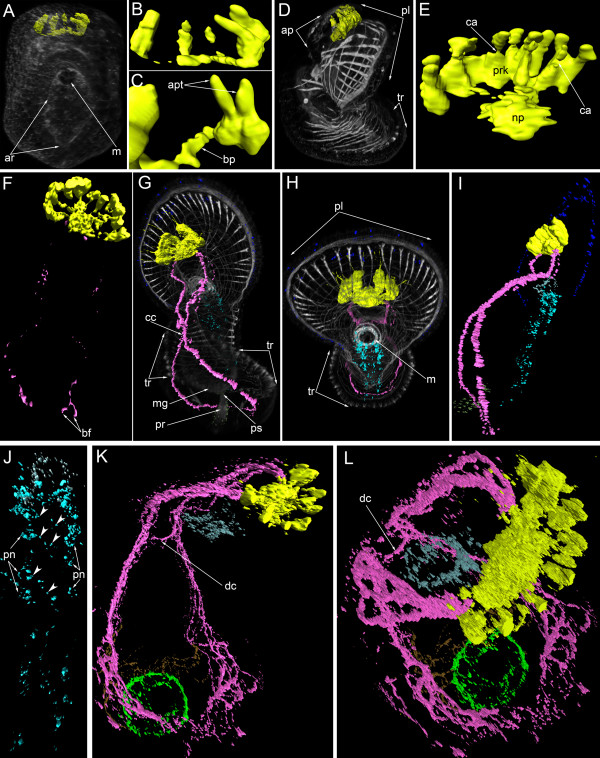Figure 3.
Three-dimensional reconstructions of the serotonin-like immunoreactive nervous system in consecutive stages of development. Color: yellow – apical organ; pink – tentacular neurite bundle; light green – telotroch neurites; dark green – nerve net around the proctodaeum; cyan – ventral nerve cord; pale blue – oral nerve ring; dark blue – marginal neurites of the preoral lobe; brown – trunk neurites; grey/white – muscle system and all actin-containing structures (parietal cytoplasm, microvilliy, etc.). (A) Mid-gastrula, dorsal view, apical is to the top. The mouth (m) and archenteron (ar) are visible. (B) Dorsal view of the apical organ which consists of four or five perikarya and their neurites. (C) Two adjacent perikarya which have two apical parts (apt) and one basal process (bp). (D) Lateral view of a preactinotrocha (ventral side to the right) showing apical plate (ap), preoral lobe, and tentacular ridge (tr). (E) Dorsal view of the apical organ in a preactinotrocha showing perikarya (prk), neuropil (np), and constricted areas (ca) between the apical and basal parts of some perikarya. (F) Dorsal view of the nervous system in a young actinotrocha, which has a large apical organ and two thin dorso-lateral branches of the tentacular neurite bundles. The branches bifurcate (bf) at the terminal end. (G) Dorso-lateral view of a 6-day-old actinotrocha (preoral lobe bends backward) showing midgut (mg), proctodaeum (pr), pyloric sphincter (ps), and tentacular ridge (tr). The two dorsal branches of the tentacular neurite bundle form close contact (cc) on the dorsal side. (H) The same larva, anterior view. The tentacular ridge contains latero-frontal cells, which have long thick microvilli strongly stained by phalloidin. The mouth is marked by thick muscles; the preoral lobe (pl) bends backward. (I) The same larva, lateral view of the nervous system. (J) The same larva; the image includes only the ventral part of the nervous system of the oral field. The paired ventral neurite bundle contains paired perikarya (pn) and thin commissures (arrowheads). (K) Ventro-lateral view of the nervous system in a 24-day-old larva. The tentacular neurite bundle is very thick and forms several loops in each tentacle. The two dorsal branches of the tentacular neurite bundle interconnect via a dorsal commissure (dc). (L) The same larva, ventro-lateral top view. Ring-shaped neurites around the mouth and the telotroch are visible.

